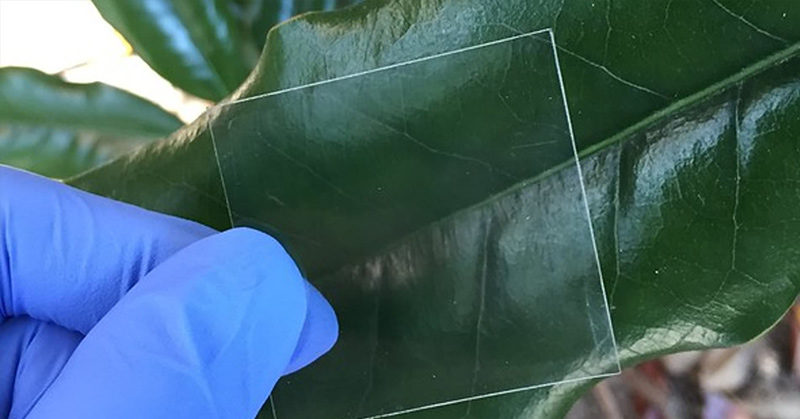It turns out in order to create the building material of the future, we have to look to the past. Newly invented transparent wood is the new material that could change the game for buildings and energy conservation.
Transparent Wood: The Material of the Future
For thousands of years, wood has been used to build homes, buildings, and more. Today, steel, concrete, and other materials have taken over. For windows, glass is the most used material, for the obvious reason that we can see through it.
Several scientists and researchers are now looking at transparent wood – wood that has been stripped of its lignin fibers – to replace glass. Not only could it make for more energy-efficient buildings, but transparent wood has a wide variety of applications that could improve a variety of industries. (1)
French architect Timothée Boitouzet started looking at wood beyond its traditional uses while studying architecture in Japan. There, buildings had to survive natural disasters such as earthquakes. (1)
“In France, we build more with concrete and stone than wood,” he said. “When I was exposed to Japanese building culture, I realized how you could build fantastic structures with wood. This material that we considered an old material, without innovation, was actually super smart. This got me excited about wood.” (1)
What is Transparent Wood?
Transparent wood is exactly what you are picturing: Wood panels that you can see through. It is made by removing the wood’s lignin and replacing it with a specific polymer. This wood is weather-proof, fire-resistant, three to five times stronger than glass, and, of course, transparent. (1, 3)
The scientists achieved this by matching the optical properties of the polymer to that of the wood. This means that light passes right through the material instead of bending, which is why we can see through it. (1)
Read: Nikola Tesla Proved It Was Possible. Now Wireless Electricity Is a Reality
Why is Transparent Wood Beneficial
For starters, transparent wood is three to five times stronger than glass. This is especially beneficial in places like Japan where buildings need to withstand extreme weather challenges. (1)
Second, wood is a much more sustainable building material than stone or concrete, as well as glass. It is a renewable resource that could help lower the construction industry’s carbon footprint significantly. (1, 2)
Materials and construction processes throughout the lifetime of a building account for 11% of the world’s global emissions. (1) Glass manufacturing emissions are around 25,000 metric tons each year, and this does not include the emissions from transporting that glass. (2) This new material is compatible with existing industrial processing equipment so the transition from old to new will be simple. (2)
Moreover, transparent wood windows could significantly cut energy costs for homes and buildings. Glass easily allows heat to transfer through it, making buildings warmer in the summer and colder in the winter. Transparent wood is about five times more thermally efficient, meaning that buildings with these windows installed would require less energy to heat and cool. (2)
Lastly, transparent wood is much lighter and less breakable than glass, making it easier to transport. It can withstand stronger impacts and if it does break, it splinters rather than shatters. (2)
Read: Student accidentally creates rechargeable battery that could last decades
Not Just For Buildings
Transparent wood isn’t only useful in homes and buildings. The automotive industry has expressed a high level of interest in the new material. (1)
Other applications include (1):
- Touch panels in cars and electronics
- Wood-panel ceilings with embedded LED lights
- “Smart windows” that can block out light when electricity is run through them
- More efficient solar panels
“We can improve the efficiency (of solar cells) because the scattering of the light (inside the wood) means that the path of the (light) is longer, so you can absorb more energy,” says Lars Berglund, a professor in wood and wood composites at the KTH Royal Institute of Technology in Sweden. (1)
Challenges and Next Steps
The biggest challenge for any new technology like this one is scalability. In the laboratory setting, you have close control over everything from start to finish. This of course has to be scaled up to the industrial level, which then becomes much harder to control. (1)
Timber, however, is easy to source. The wood comes from different tree types, such as (1):
- Beech
- Pine
- Poplar
- Birch
- Balsa
Researchers are also wanting to make transparent wood as environmentally sustainable as possible. This means retaining as much as the lignin in the wood as possible so less material has to be discarded. Keeping more lignin in the panels also means buildings will retain more carbon. (1)
“If you remove it, you’re adding a chemical step which is going to cost energy, require solvents,” said Prof. Berglund. “So far, we have used petroleum-based polymers to impregnate the wood, but we’re working very intensely now to use a bio-based polymer,” (1)
Though there is still a ways to go before transparent wood is a commonly-used product, it is well on its way to becoming a sustainable building material of the future.
Keep Reading: Try not to jiggle while watching these amazing bladeless wind turbines

